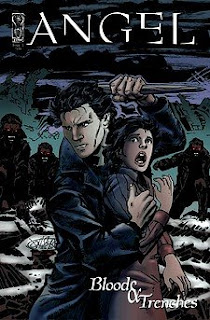Angel: Blood & Trenches #1
John Byrne
.
 John Byrne tackles Joss Whedon's creation Angel in the new series from IDW Publishing, Angel: Blood & Trenches, in which we get a glimpse into the vampire-with-a-soul's past. I hadn't really heard too much about this book before its release, but it was a really well-done issue. A great, solid story depicts Angel during World War II, where vampires are secretly used by Germany, and Angel is suspected of infiltrating a French camp by none other than a descendant of Wesley's, Colonel Geoffrey Wyndam-Price (a really neat idea). I was a little surprised upon opening the comic that it was an uninked, uncolored book (for the most part, although there are splashes of color here and there - usually blood), but I didn't really mind it once I started reading the story. John Byrne's art is really quite beautiful here and he makes smart choices in terms of telling this story. I would say that the story is a little more immediately appealing than the recent Angel: After the Fall (although I feel that that mini-series sort of redeemed itself later on), and the art is certainly leaps and bounds better. This is turning out to be a striking story in the history of Angel from a legendary artist who has proved time and time again through consistenly compelling stories (and well into his career) that he's still got it.
John Byrne tackles Joss Whedon's creation Angel in the new series from IDW Publishing, Angel: Blood & Trenches, in which we get a glimpse into the vampire-with-a-soul's past. I hadn't really heard too much about this book before its release, but it was a really well-done issue. A great, solid story depicts Angel during World War II, where vampires are secretly used by Germany, and Angel is suspected of infiltrating a French camp by none other than a descendant of Wesley's, Colonel Geoffrey Wyndam-Price (a really neat idea). I was a little surprised upon opening the comic that it was an uninked, uncolored book (for the most part, although there are splashes of color here and there - usually blood), but I didn't really mind it once I started reading the story. John Byrne's art is really quite beautiful here and he makes smart choices in terms of telling this story. I would say that the story is a little more immediately appealing than the recent Angel: After the Fall (although I feel that that mini-series sort of redeemed itself later on), and the art is certainly leaps and bounds better. This is turning out to be a striking story in the history of Angel from a legendary artist who has proved time and time again through consistenly compelling stories (and well into his career) that he's still got it.
.
 John Byrne tackles Joss Whedon's creation Angel in the new series from IDW Publishing, Angel: Blood & Trenches, in which we get a glimpse into the vampire-with-a-soul's past. I hadn't really heard too much about this book before its release, but it was a really well-done issue. A great, solid story depicts Angel during World War II, where vampires are secretly used by Germany, and Angel is suspected of infiltrating a French camp by none other than a descendant of Wesley's, Colonel Geoffrey Wyndam-Price (a really neat idea). I was a little surprised upon opening the comic that it was an uninked, uncolored book (for the most part, although there are splashes of color here and there - usually blood), but I didn't really mind it once I started reading the story. John Byrne's art is really quite beautiful here and he makes smart choices in terms of telling this story. I would say that the story is a little more immediately appealing than the recent Angel: After the Fall (although I feel that that mini-series sort of redeemed itself later on), and the art is certainly leaps and bounds better. This is turning out to be a striking story in the history of Angel from a legendary artist who has proved time and time again through consistenly compelling stories (and well into his career) that he's still got it.
John Byrne tackles Joss Whedon's creation Angel in the new series from IDW Publishing, Angel: Blood & Trenches, in which we get a glimpse into the vampire-with-a-soul's past. I hadn't really heard too much about this book before its release, but it was a really well-done issue. A great, solid story depicts Angel during World War II, where vampires are secretly used by Germany, and Angel is suspected of infiltrating a French camp by none other than a descendant of Wesley's, Colonel Geoffrey Wyndam-Price (a really neat idea). I was a little surprised upon opening the comic that it was an uninked, uncolored book (for the most part, although there are splashes of color here and there - usually blood), but I didn't really mind it once I started reading the story. John Byrne's art is really quite beautiful here and he makes smart choices in terms of telling this story. I would say that the story is a little more immediately appealing than the recent Angel: After the Fall (although I feel that that mini-series sort of redeemed itself later on), and the art is certainly leaps and bounds better. This is turning out to be a striking story in the history of Angel from a legendary artist who has proved time and time again through consistenly compelling stories (and well into his career) that he's still got it.


Comments